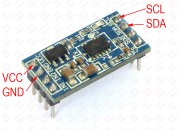Accelerometers are recently developed solid state electronics devices that makes it very easy to measure acceleration. They are completely modular and very tiny devices which gives voltage proportional to acceleration. These type are called analog accelerometers as their output is voltage. Some other gives a PWM output or direct binary digital data, they are called digital accelerometers. Accelerometers are used widely in modern devices. Apple iPhone,iPad and Nokia series 60v5 devices for automatic screen orientation changing. Also for motion gaming and other showoff stuff like Xpress Beer in above devices. Portable Hard disk and Notebooks for fall detection. Anti-theft devices. Motion Gaming Consoles like Nintendo Wii. Balancing Robots and UAVs. Experiments which needs to find force, like car crash experiments. And Possibly many other. Accelerometers can measure acceleration in 2 dimensional or 3 dimensional space. They are called 2D and 3D accelerometers respectively. Accelerometers have certain range, i.e. the maximum acceleration they can measure. It is specified in terms of g. ‘g’ is the acceleration due to gravity of earth and it is equal to 9.80665m/s2. Common accelerometers can have a range of 1.5g to 6g. It is obvious that 1.5g accelerometer is more precise than 6g. So use 1.5g where more accuracy is needed while use 6g for much more harsh experiments. Renault R26 can pick up 100km/hr is […]

